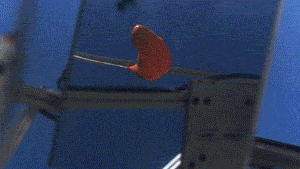Back in May, our friend and ex-NASA JPL engineer Mark Rober, figured out a way to shoot “bullet time” videos on the cheap, with a ceiling fan, a pair of torches and a GoPro. Pretty damn creative, but the rig had its limitations. So Mark set out to find a way to create a similar setup, this time using a high-end Phantom camera. Thank goodness.
Upgrading the camera from a GoPro wasn’t just a simple swap-and-shoot operation though. The Phantom cam is too big, too heavy and way too expensive to put it on a spinning arm. The G-forces alone could break it. So Mark recruited another engineer friend from NASA JPL, and the two of them designed this rig, which is more than a little nuts.
Rather than spinning the camera itself, the rig uses a freaking scooter motor to spin two mirrors on aluminium arms. This way, we get that coveted rotating-around-an-object perspective, while the expensive camera is safe and sound on the ground below, shooting at a mighty 7200 frames per second. The images that come out are really pretty amazing. The water balloons toward the end especially blow me away.
According to Mark, thais rig has been redesigned about fifteen times over the last few months, and with every failure they would learn something new, and then improve upon it. The process of making this rig actually inspired our other friend Destin over at Smarter Every Day to make a video about better design through trial and error.
That also means that the end result doesn’t contain the razor-sharp footage The other problem is that those mirrors make the camera seem kind of far away from the subject. They tried to use a 105mm lens, but it simply didn’t let enough light in, even in the bright, noon, LA sun. So they had to go to a 50mm lens, which gets plenty of light, but it’s a much wider point of view, making the subject appear further away and smaller. Essentially this yielded a comparatively small square of useable footage, as you can see in the GIF Mark sent us made from the raw footage. That meant it had to be cropped and stretched in order to fit into the 720p frame of the final video, which caused further pixel degradation.
And lastly, because they shot with a 50mm lens pretty much wide open, that gave them a very shallow depth of field. You can see in most of the clips there is a point that’s in focus which is then surrounded by softer focus. That’s what happens with any camera when you’re shooting wide open.
So, was the rig perfect? No, but you’ve got to consider the parameters they were working with, especially a) don’t get the rig in the shot, and b) don’t put the camera that costs as much as a car in jeopardy. And it still produced some pretty amazing shots.
Truth be told, from our chat with him on the phone, we wouldn’t be surprised if Mark comes back to this. He was already talking about subbing in better mirrors. I wonder if he could go back to the 105mm lens, rent pair searchlights, and then absolutely blast his subjects with light. Hey, I’m no NASA engineer, but I’m looking forward to seeing where those who are take this concept next. [Mark Rober’s YouTube Page]
